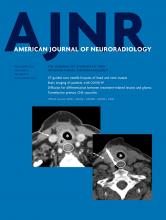Research ArticleNeurointervention
Open Access
Computational Fluid Dynamics Using a Porous Media Setting Predicts Outcome after Flow-Diverter Treatment
M. Beppu, M. Tsuji, F. Ishida, M. Shirakawa, H. Suzuki and S. Yoshimura
American Journal of Neuroradiology November 2020, 41 (11) 2107-2113; DOI: https://doi.org/10.3174/ajnr.A6766
M. Beppu
aFrom the Department of Neurosurgery (M.B., M.S., S.Y.), Hyogo College of Medicine, Hygo, Japan
M. Tsuji
bDepartment of Neurosurgery (M.T., F.I.), National Hospital Organization Mie Chuo Medical Center, Tsu, Mie, Japan
F. Ishida
bDepartment of Neurosurgery (M.T., F.I.), National Hospital Organization Mie Chuo Medical Center, Tsu, Mie, Japan
M. Shirakawa
aFrom the Department of Neurosurgery (M.B., M.S., S.Y.), Hyogo College of Medicine, Hygo, Japan
H. Suzuki
cDepartment of Neurosurgery (H.S.), Mie University Graduate School of Medicine, Tsu, Mie, Japan.
S. Yoshimura
aFrom the Department of Neurosurgery (M.B., M.S., S.Y.), Hyogo College of Medicine, Hygo, Japan

References
- 1.↵
- 2.↵
- Becske T,
- Brinjikji W,
- Potts MB, et al
- 3.↵
- Cruz JP,
- Chow M,
- O’Kelly C, et al
- 4.↵
- 5.↵
- Umeda Y,
- Ishida F,
- Tsuji M, et al
- 6.↵
- 7.↵
- 8.↵
- 9.↵
- Murray CD
- 10.↵
- Ford MD,
- Alperin N,
- Lee SH, et al
- 11.↵
- Akgiray Ö,
- Saatçı AM
- 12.↵
- Derdeyn CP,
- Chimowitz MI,
- Lynn MJ, et al
- 13.↵
- Sugiyama S,
- Niizuma K,
- Sato K, et al
- 14.↵
- 15.↵
- Chung B,
- Mut F,
- Kadirvel R, et al
- 16.↵
- 17.↵
- Mut F,
- Raschi M,
- Scrivano E, et al
- 18.↵
- 19.↵
- Tsuji M,
- Kishimoto T,
- Tomoyuki K, et al
- 20.↵
- Damiano RJ,
- Tutino VM,
- Paliwal N, et al
- 21.↵
- 22.↵
In this issue
American Journal of Neuroradiology
Vol. 41, Issue 11
1 Nov 2020
Advertisement
M. Beppu, M. Tsuji, F. Ishida, M. Shirakawa, H. Suzuki, S. Yoshimura
Computational Fluid Dynamics Using a Porous Media Setting Predicts Outcome after Flow-Diverter Treatment
American Journal of Neuroradiology Nov 2020, 41 (11) 2107-2113; DOI: 10.3174/ajnr.A6766
0 Responses
Jump to section
Related Articles
- No related articles found.
Cited By...
This article has not yet been cited by articles in journals that are participating in Crossref Cited-by Linking.
More in this TOC Section
Similar Articles
Advertisement











